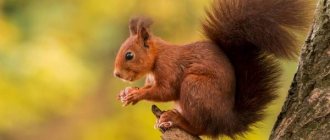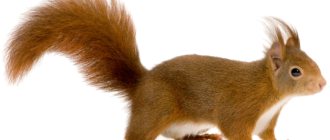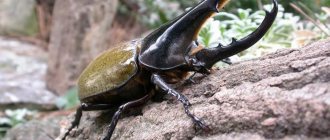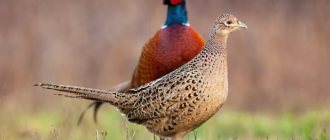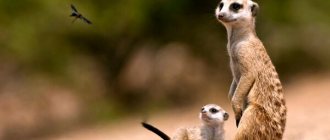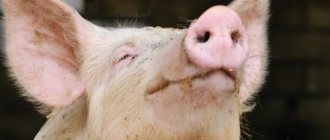Everyone knows what meerkats look like and everyone knows that they are cute and curious, but hardly anyone knows more about them. The meerkat is a species of small carnivorous mammal whose natural habitat is desert areas. However, the number of people interested in breeding meerkats at home is growing every year. What do you need to know about animals before buying them? Look at the photos of these cute faces.
Appearance and size
Some associate them with squirrels, others compare them with pine martens or beavers. There are many associations, but in fact, the meerkat is a small predator with a body length of 25-35 cm, a tail length of about 20 cm and a weight of 600-900 g. Their silhouette is slender, elongated and pointed, their ears are small and round. The limbs are quite short, the fingers end in long sharp claws. The upper body is covered with soft, abundant gray fur with brown stripes. The underside of the body is sparsely covered with hair. The muzzle and cheeks are light, with dark lines around the eyes. The yellow tail ends in a black tip.
This is what meerkats look like in a general description (yes, the same ones that advertised the Metro every day and danced in advertisements for chocolate products). These cute creatures can be found mainly in southern Africa, mainly in the Kalahari Desert.
Is it possible to keep meerkats at home?
It is possible, but it is not an easy task. These animals cost several thousand rubles. Yes, these are very cute animals, but they also have many shortcomings. They emit unpleasant odors, like to make a big mess, and should have a large cage with a lot of sand. There is also a problem with feeding these animals because they eat larvae, small reptiles, birds... Feeding meerkats is disgusting to many people. It is usually not recommended or encouraged to breed such a pet at home.
Meerkats are carnivores that can be tamed and treated like other farm animals. These mammals are gaining popularity in Europe - now they can be found not only in zoos, but also in apartments, which would have been unthinkable just a few years ago. In Africa, animals are kept indoors because they fight with rodents. Their presence near populated areas can be compared to the presence of cats living on farms in rural areas, where they hunt mice and rats.
Interesting Facts
Meerkats gained enormous popularity thanks to the film “The Lion King,” in which an animal of this species appeared in one of the main roles. The meerkat from the film was named Timon, and it was he and Pumbaa who took into their herd a small, lost lion cub - Simba. Since the release of The Lion King, audiences have become increasingly interested in this species.
Currently, in many countries, meerkats are bred and kept at home, which was made possible due to their adaptability. Animals quickly adapt to new conditions and can live in harmony with humans.
In addition, meerkats are extremely social animals. They live in herds of up to 30 individuals, have their own warning system and... training system. They say that they organize so-called “Hunting Schools”. They systematically show young people how to deal with dangerous scorpions.
They are usually photographed in a characteristic upright pose on two legs. They look like they want to hide something on their stomach.
Breeding
Breeding animals is a responsible task. The animal itself will fit well into its new environment, but it should be provided with additional equipment that will help it feel at home. A mandatory purchase is a large terrarium and a good heating lamp that will imitate the sun's rays. It is also worth having holes for meerkats to hide in, and scratching posts to remove burrs from their claws.
Reproduction and development
In a group of meerkats, only the dominant pair reproduces. The others help her look after the cubs. Pregnancy lasts 11 weeks, after which the female gives birth to 2-4 cubs in the burrow. Feeds them milk for 10 weeks. When it goes with its partner in search of food, other members of the herd look after the children. The female brings only 1 litter per year. A meerkat lives up to 6 years.
How much does a meerkat cost?
The price of a meerkat ranges from 20 to 50 thousand rubles. However, keep in mind that these are not the only costs you will have to pay. They are herd animals, which means they are much better suited to large groups. For animals to feel good and happy outside of their natural habitat, they need company. It is recommended to buy at least two meerkats. Thanks to this, animals will be able to feel comfortable and satisfy their herd instincts. In addition, the costs of required equipment for home breeding should also be taken into account.
Meerkat in the wild
Meerkats' natural habitat is in the desert regions of Africa. The largest number of animals can be found in the Kalahari Desert, Namibia and Angola. Animals are diurnal, living in herds consisting of several dozen individuals, which in turn are divided into family groups, i.e. a pair of animals (female and male) and their young offspring. They dig holes for themselves in whole herds, and also willingly use nearby rocks and stones.
When searching for food or exploring unknown areas, at least one member of the herd will climb to the highest point in the area, stand on its hind legs and look for a possible threat. Its job is to inform other meerkats of impending danger, which is done by making a loud warning sound. They live in South Africa, Angola, Namibia, Southern Botswana.
photo source
Lifestyle
This species is diurnal and loves to bask in the sun in large numbers. Shows strong social bonds and usually lives in colonies of at least 10 individuals. He is often in the company of other species - mongooses or even rodents. It is a shy animal, usually hanging around its burrows. Such burrows may consist of several tunnels with multiple entrances. In rocky areas, animals use rock crevices as shelter.
For the safety of the entire group, a guard is posted (this role is alternately performed by many members of the colony), who observes the surroundings in a characteristic standing position. The vantage point can be the top of a tree, bush or rock. The sentry makes constant low squeals, informing the rest of the group that he is on duty. When it sees a predator, it raises the alarm early enough for the rest of the colony to hide in its burrows.
Nutrition
Meerkats delicacy include beetles, as well as butterfly larvae and pupae. It also eats other insects, scorpions, reptiles and birds and their eggs, small mammals and even rhizomes and roots. During a hunt, it jumps on prey at high speed and kills it with a bite to the back of the head. Animals are omnivores, but the main elements of their diet are insects, small rodents and plant roots, which contain a lot of water.
Interesting for you:
Keeping a meerkat at home
Meerkats adapt well to life in captivity and are easily tamed;
they are cheerful, active, curious, playful and affectionate, just like kittens, and remain so until old age (and these animals live in captivity for more than 12 years). These qualities make meerkat very attractive to keep at home. But since in nature these animals are accustomed to living in large families, it is better to have not one, but two meerkats; if you don’t want to get offspring from them, you can have same-sex offspring. The two animals will never be bored - there is always someone to play with and someone to take care of - this is very important for meerkats. A human is a friend to a meerkat, but still cannot replace his family.
Meerkat as a pet
Meerkats are friendly and sociable and generally get along well with other pets such as cats, ferrets and small dogs. To some extent, the presence of four-legged animals in the house can even compensate for the lack of attention from the owner.
Meerkats love to “talk” and make more than 30 sounds that express various emotions, but at the same time they cannot be called noisy animals.
Meerkats do not need a cage. Their territory is the entire apartment. The curious animal loves to move freely around rooms and watch what is happening around. At the same time, as a rule, they do not damage furniture and things, and do not chew wires. The pet will only need a house with bedding - here he will sleep. Since meerkats naturally live in burrows, an elongated house is suitable.
For the safety of the animals, some owners lock the meerkat in a cage in their absence. The cage should be so spacious that the animal can calmly manage, without restricting its movements. The cage should have everything you need - a soft bed, bowls of water and food, a tray.
It will be more difficult to toilet train a meerkat than a kitten, but a patient owner can do it. You can use the same cat litter box as a toilet, just don’t forget to change the litter more often.
As desert natives, the animals do not tolerate cold and drafts, but love the sun and warmth. In their homeland, meerkats love to sunbathe. When keeping a meerkat at home, he should also have this opportunity. In summer, there are no problems with sunlight, under the rays of which the animal could bask - it is enough to provide it with access to one of the window sills on the sunny side. But in winter, it is recommended to install a UV lamp in a suitable place, so that at this time of year your pet can bask in the rays of the sun, albeit artificial.
Meerkats also love sand. Please your pet - arrange a mini sandbox for him, where he will enjoy spending time.
Don't forget about toys. Nowadays, pet stores have a wide selection of toys for any pet - choose something that rustles and squeaks for your pet.
Bathing
The fur of a meerkat gets dirty, especially if the animal walks outside. You need to wash your pet's paws after every walk. And at least once a month, the meerkat will need to be bathed using a mild pet shampoo. It is better to do this in a washbasin under running warm water. In this case, it is necessary to ensure that water does not get into the animal’s ears, otherwise the consequences may not be the most pleasant (you may even have to contact a veterinarian). Meerkat swimmers are unimportant, so they should not be allowed to swim freely in a basin of water. After water treatments, do not let the animal run around the apartment; first wipe it with a towel and then dry it with a hairdryer.
Walks in the open air
In good weather, you can go for a walk with the meerkat. This is a very exciting event. To prevent your pet from running away, you only need to walk it with a harness (a harness is suitable for young ferrets). They walk with the meerkat only in the warm season.
It is necessary to keep in mind that you can walk with a meerkat only after all the necessary vaccinations (against plague and rabies). Meerkats are vaccinated in the same way as ferrets.
If the meerkat walks outside, or if you also have cats or dogs, the meerkat should be treated for fleas and ticks.
What kind of lamp does a meerkat need?
They are quite heat-loving, so make sure that there is additional heating in winter; buy a UV lamp for the meerkat, under which your pet can warm its tummy. In summer, it is advisable to provide the meerkat with access to one of the windowsills on the sunny side.
Interesting materials:
How to upload a photo to Yandex Disk using a link? How to upload a photo from Skype? How to upload multiple photos to Instagram from a computer? How to upload video to Snapchat? How to access port 8080? How to log in to Rutracker 2022? How to access the site bypassing the blocking? How to log into an old account on Tik Tok? How to log into your old WhatsApp account? How to enter bios windows 10 2022?
Reproduction and offspring
Thin-tailed myrcats reach sexual maturity at the end of the first year of life. An adult healthy female can give birth to up to 4 litters per year, each of which can contain up to seven puppies. Meerkats breed between September and March.
The female's pregnancy lasts an average of 77 days. Puppies are born blind and helpless. The weight of a newborn meerkat is about 30 grams.
By the age of two weeks, meerkats open their eyes and begin to learn to live as adults. Small insects begin to appear in their diet after two months. At first, the cubs are fed by the mother and other members of the pack, then they begin to hunt on their own. The upbringing of the younger generation falls on the shoulders of their adult brothers and sisters. They monitor young meerkats, organize games and protect them from possible danger from predators.
Adult Mirkats train young animals, and this does not happen in a passive way. Grown-up puppies accompany adults on the hunt. First, they are fed prey that has already been killed, then it is neutralized, but still alive. In this way, the juveniles learn to catch and deal with prey, and they are accustomed to new food. Then the adults only watch the young animals hunt, helping in rare cases to cope with larger or more dexterous prey that the teenager cannot handle on his own. Only after making sure that the cub can handle it on his own is he allowed to hunt on his own.
During training, adult meerkats try to “introduce” the young to all possible prey - snakes, lizards, spiders, centipedes. It is almost impossible for an independent adult meerkat not to have an idea of how to deal with one or another edible enemy. Growing up meerkats can leave the family and try to found their own clan. In this case, after leaving, they are declared a kind of vendetta from their own family - they are recognized as strangers and, if they try to return, they will be mercilessly expelled from the territory.
Lifestyle and habitat
Meerkats are small burrowing animals. They do not dig single holes, but entire networks with several entrances and exits. Dwellings are used for overnight stays, shelter from the heat during the day, escape from predators, and the birth of offspring.
A group of meerkats is a social association with complex internal connections. Usually there are 10-20 individuals. But there may be numerical deviations in one direction or another. The minimum number is 3-4 individuals. Sometimes large families with fifty members arise. The largest observed family consisted of 63 animals.
The most visible organizational technique is constant security activity. Several meerkats act as observers. The watchmen stretch out in columns and survey the surrounding space, not forgetting about the sky.
When a bird of prey or a ground enemy appears, the sentries give a signal. The whole family rushes into the underground dwelling. Several entrances to the system of holes and shelters allow evacuation to be carried out very quickly. After some time, the first guard appears from the hole. If there are no threats, the entire group returns to the surface.
About meerkats , it is true that the unifying force of any team is the exchange of messages. The role of the most obvious signaling device is played by the tail. A special place is occupied by sound signals - very informative means of communication.
Researchers counted about thirty different sounds, or, as scientists say, words. Words are combined into phrases. That is, the cry of a meerkat can be polysyllabic.
Audio messages have a very specific meaning. For example, the cry of a sentry can inform a family not only of the approach of a predator, but of its type and degree of danger.
Animals react differently to the cries of guards. If a ground enemy approaches, meerkats hide in holes, but can simply group around the cubs. When threatened from the air, meerkats crouch and begin to peer into the sky, or immediately retreat to shelter.
Behavior depends on the sentry's signal, which contains three gradations of danger: high, medium and low.
The family's actions are led by the alpha pair. It is dominated by the female. That is, matriarchy reigns in the meerkat community. Which is not uncommon in packs of predators. The main female has the privilege of bearing offspring. Responsibility is to manage relationships within the family and guide the actions of the clan in the event of conflicts with neighboring groups of animals.
The meerkat clan controls an area of about three to four square kilometers. Constantly ensures that neighboring families do not trespass. But the world is not eternal. We have to repel attacks or conquer new territories. The fighting can be very cruel and bloody. Numerical superiority and experience of the alpha female wins.
The process of training a meerkat to use a tray
The process of toilet training a pet is quite simple and does not involve any difficulties. The animals are very trainable. First you need to observe your pet, and when he wants to relieve himself, you should transfer him to the tray. If you do not have time to move the pet to the right place, you need to remove what he has done and put it in the tray, put the meerkat there and show him the result of his actions. After the meerkat has mastered the correct way to go to the toilet, be sure to give the animal something to eat. A couple of such trainings, and the meerkat will understand where it needs to do its business.
Before the animal goes to sleep in its house, it is necessary to put a diaper there, since in the dark the pet will not go out to relieve itself. This behavior is also typical for it in its natural habitat, since a meerkat will never leave its hole at night and will not expose itself to danger.
Description and features
The proportional body of the animals is equipped with high legs with four-toed feet and a long, thin tail. Meerkats have strong claws on their front paws. They are used for digging holes and extracting insects from the ground.
An adult animal weighs from 600 to 1200 grams. The body is approximately 30 cm long. Covered with coarse fur, colored gray with the addition of mustard, red or brown tones. Fuzzy transverse stripes run along the back. The fur on the legs and belly is sparse and lighter.
Dark contours around the eyes visually enlarge the already large organs of vision. Large eyes in nature often play a frightening, intimidating role. The meerkat sees well and is prone to farsightedness. The eyes are helped by a keen sense of smell and good hearing.
The ears are small, crescent-shaped. They are painted black and are located at eye level. A distinctive feature is the ability to close the ear canals. This saves the ears from getting sand and earth when digging holes.
Meerkats' muzzles taper to a soft, brown nose. This organ provides a very subtle sense of smell. And this, in turn, allows you to smell potential food underground at a depth of 20-30 centimeters.
Mouth of medium size. Equipped with numerous sharp teeth. Their set includes all the required types: incisors and canines, which a predator cannot do without, as well as premolars and molars.
The general configuration of physiognomic features creates the impression that the meerkat animal is a curious and cunning creature. This feeling is enhanced by the routine manner of stretching out in a column and carefully observing the surrounding space.
Meerkats have a tail up to 25 centimeters long. Looks thin due to lack of fur decoration. Meerkats often stand on their hind legs, the tail helps maintain an upright position.
During combat with a snake, it acts as a decoy
A black spot on the tip of the tail helps to distract the reptile's attention. In addition, it works as a signal flag
Assists in organizing collective actions and movements.
Meerkats move with support on all four paws. The movement speed reaches 30 km/h. Paws allow you not only to run, but also to stand. Considering that elevations are chosen for guard positions, the meerkat’s overall height allows it to inspect the savannah or desert right up to the horizon.
If the hind legs make it possible to remain in an upright position, the front legs are involved in digging. The meerkat has 4 claws on all paws. But on the front they are longer and more powerful. They reach 2 cm in length and are curved like the teeth of an earthmover.
This is not a military weapon, but a working tool. With the help of its claws, in one minute a meerkat can dig a hole that can accommodate its entire body. Or, when searching for food, bring to the surface soil several times more than its own weight.
Nutrition
The main source of nutrients for slender-tailed myrkats are insects. But reptiles, lizards and snakes, attract no less attention from these predators. The eggs, no matter who lays them, are used as food not only by meerkats, but also by all predatory and omnivorous animals. Despite their carnivorous nature, mongoose relatives eat some plants and fungi. For example, truffles from the Kalahari Desert.
At the age of one month, young meerkats begin to feed on their own. As they grow older, they learn the rules of hunting. Puppies must learn how to behave around poisonous creatures. There are quite a few of them in the diet of animals. Meerkats are not immune to all poisons.
In addition, the young learn to interact with other members of the group. The process of mutual learning and mutual assistance lasts as long as meerkats live . Foraging for food is a complex collective action. While some are digging food out of the ground, others are watching what is happening around them.
To have or not to have a meerkat at home?
Before you get a meerkat, you need to know that the behavior of a wild meerkat or a captive-bred meerkat is radically different from the behavior of an animal raised at home. House-bred meerkats do not dig holes, since they are not faced with the task of getting food. Food is already in abundance in the feeder. Also, domestic meerkats will not try to bite any of the family members when they try to pick up the animal. Because they are played with and picked up from a very young age. Although if the animal doesn’t like something, you won’t have to wait long for a response, and it will definitely bite. But the animal’s reaction in any case depends on the pet’s mood and temperament.
In the wild, meerkats, both female and male, leave many scent marks to mark their territories. In the apartment they behave the same way and mark their possessions by rubbing against their house, feeder or toilet. The odorous secretion released from the glands of meerkats is absolutely imperceptible to the human sense of smell. Therefore, you will not hear the characteristic smell, like after ferrets. A slightly unpleasant odor may come from the restroom where the animal relieves itself. To avoid bad odors in your home, you should use good cat litter and clean and clean the litter box daily. Then the unpleasant smell will not become a hallmark of your home.
Meerkats get along well with other animals, cats or dogs. But only if they are friendly or there are no other meerkats. In the presence of other meerkats, a family group will form that will jealously defend its territory from strangers, and the dog or cat will be repeatedly hit.
Meerkats treat strangers with fear and interest. When guests arrive at the house, the animals watch them with curiosity, examine and sniff them, without showing aggression.
Hygiene
Meerkat often needs bathing. If the owner walks him, then the pet should wash his paws after each walk.
You should bathe your animal monthly with a non-aggressive pet shampoo. A washbasin is suitable for this purpose. During the procedure, it is important to ensure that water does not get into your pet’s ears.
Meerkats are not very good swimmers, so you shouldn’t put them in a bowl of water for this purpose.
After washing, the animal should be dried with a towel and dried with a hairdryer. Only after this can you let him run around the apartment.
Nutrition of meerkats, feeding meerkats at home
In nature, due to varying availability of food, the diet may vary from day to day. Meerkats primarily feed on insects, but their diet also includes lizards, snakes, spiders, centipedes, scorpions, bird eggs and some plants. According to some reports, the daily diet of a meerkat consists of 82% insects (butterflies and moths, beetles, termites, grasshoppers, insect larvae, crickets, ant larvae - they especially love it). Insects are an excellent source of food as they reproduce very quickly and are always in abundance, 7% are arachnids, 3% are centipedes and millipedes, 2% reptiles, 2% amphibians and 1% small birds.
Meerkats are much less sensitive to the venom of reptiles and arthropods. They are resistant to many deadly poisons, making their natural diet more varied than that of other local predators. The diet also includes worms. 3% can be plant food - eating melons, root vegetables and tubers increases during the dry period.
Sometimes meerkats collect food for babies and nannies and bring it to their den. Babies learn to look for food by following adults and expand their diet. The puppy that makes the loudest call receives the most food from the adults.
In captivity, they can feed on live food that is available in pet stores (mice, worms, feeding insects, etc.). The industry does not produce special food for meerkats. When it comes to dry food, only high quality products are suitable. Meerkats do not tend to overeat, so automatic feeders are suitable for them. But insects should still be included in the diet, at least as a delicacy. Feeding insects – feeding crickets, cockroaches, zoophobes, mealworms, etc. One liter of zoophobas is enough for one meerkat for one month (about 50 larvae per day).
The meerkat's diet may include meat - rabbit, domestic chicken, beef (not often), quail, small lizards... Baby meat puree (rabbit, chicken, without milk and sugar). But remember that you cannot feed an animal only selected meat; it contains a lot of protein, but lacks other useful substances, vitamins, and minerals. You cannot feed meerkats pork, lamb, lard; duck, goose, any fried meat, sausages, smoked meats and other purely human food containing salt, spices, etc. are also prohibited.
You should be careful with fish, this is an unusual food for a meerkat and many varieties of fish contain components harmful to them (trimethylamine oxide and thiaminase, a substance that destroys vitamin B1 in the body).
As an additional source of nutrition, you can give boiled chicken eggs (half, once a week), raw chicken eggs make meerkats weak, quail eggs (two to three times a week, raw can be), dried tendons (rarely, as a treat).
Milk is not given to adult meerkats, but fermented milk products can be useful, but are offered to the animals only in the form of low-fat products. Cottage cheese, kefir, live yoghurts. Remember that milk and sour cream should not be given to meerkats.
Plant foods, as in nature, should not form the main part of the diet. Fruits and vegetables are cut into small pieces or grated. Vegetables can be mixed with minced meat - carrots, pumpkin, tomato, sweet pepper, cucumber, broccoli, cabbage, zucchini. Meerkats cannot eat potatoes at all. Fruits - banana (except dried), mango, avocado (very rare), apple, pear, melon, watermelon, persimmon, grapes (very rare and limited), cherries and cherries (pitted), strawberries, wild strawberries, gooseberries.
Also, meerkats should not be given mushrooms, nuts, onions, garlic, food from the table (soups, cereals...), salty, spicy, sweet, sour, spices, herbs, soy products, products with preservatives, as well as cookies, chips, popcorn and etc.
Depending on the type of feeding, age and body condition, the animal may need additional vitamins and minerals; consult a veterinarian at the clinic about this.
About the frequency of feeding - cubs up to five months of age are fed four times a day, older ones up to ten months - three times a day, and adult meerkats are fed twice a day.
What to feed a meerkat
Meerkats are not picky when it comes to food, and creating the right diet for your little predator will not be difficult.
Special food for meerkats is not yet available, but you can give them food intended for dogs or cats, but only high-quality ones.
A meerkat’s diet must include meat – raw or boiled beef, chicken, quail, rabbit. But giving only meat is wrong. It contains a lot of protein, but not enough other nutrients, vitamins and minerals.
Live food (crickets, cockroaches, zoobass, mealworms) is usually always available in pet stores. They must also be included in your pet’s diet.
Babies and adolescents up to five months are fed 4 times a day, young animals from 5 to 10 months - 3 times a day, adult animals are enough to be fed 2 times a day. As a rule, meerkats do not have a tendency to overeat, and they do not eat more than required.
The share of plant foods in a meerkat's diet should be insignificant. Fruits and berries (apples, bananas, mangoes, persimmons, watermelon, strawberries, cherries, etc.) are cut into small pieces. Grated or finely chopped vegetables (any except potatoes) can be mixed with minced meat.
As an addition to the main food, half a boiled chicken egg is given once a week, and a quail egg (can be raw) 2-3 times a week.
From dairy products, you can sometimes give low-fat kefir, cottage cheese, and yogurt.
What should you not feed a meerkat?
The meerkat should not be offered fatty foods, as well as milk and sour cream - they are poorly absorbed by the predator’s body. Fatty meat and poultry (pork, lamb, goose, duck) and human food such as sausages, smoked meats and other products containing soy, salt, spices and preservatives are prohibited. In addition, mushrooms, nuts, onions and garlic should not be given.
Separately, it is necessary to say about feeding meerkat fish. You need to be very careful here. This food is unusual for meerkats, and many varieties contain components harmful to the animals - trimethylamine oxide and thiaminase. Occasionally, a meerkat can be given pink salmon, taimen, grayling, sockeye salmon, omul, chinook salmon, salmon, and chum salmon. The fish should be boiled and all the bones should be removed.
Meerkat: description of the angel of the sun, photo
The length of the meerkat’s body including the head is 25-35 cm, the tail is 18-25 cm, weight is up to 1 kg. Females are slightly larger than males. Meerkats are slender animals, but their long fur makes them appear heavier than they actually are. Thin limbs, an elongated head and “innate sunglasses” - dark spots around the eyes - give the animal a funny and touching appearance.
Color varies from silver-brown to orange-brown. At the same time, the head and abdomen are very light, the ears are black, the slightly pubescent tail is yellow, and its tip, like the ears, is black. Dark spots on the back coincide with the transverse stripes. This camouflage coloring perfectly helps the animals blend in with the brownish soil. Coupled with a perfect guard system, this property helps meerkats maintain their population. In the photo, meerkats greet the sunrise.
Meerkat lifestyle in nature
Meerkats are active during the day. They feed mainly on insects and their larvae, arachnids (including scorpions), as well as mice, small reptiles, birds, eggs, tubers and plant bulbs.
Family matters
Meerkats are territorial animals, the size of their habitat is about 5 sq. km.
They live in communities (families). 20 is the usual number of animals in a group. However, the number of some communities often reaches 40 or more individuals. The sex ratio in the group is approximately equal. There is a separate hierarchy for males and females. The head of the family is the female, who chooses a mate from among the dominant males. In the entire large family, as a rule, only the dominant pair reproduces.
Meerkats are very prolific - a female can give birth to offspring up to four times a year. Pregnancy lasts 11 weeks. Most often, 4 cubs are born, which are cared for by all members of the community. At first, the whole family feeds the kids with insects and larvae, and when they grow up a little, the elders teach them how to hunt and how to properly handle prey.
Taking care of the baby
Young meerkats devote all their free time from training to games. Their favorite pastimes are chasing each other, jumping on each other, and wrestling. They often involve adults in their games.
Meerkats love games
Meerkats respect family values. Cases of aggressive behavior within the community are rare. Meerkats know that the more united the clan, the better life for all its members. According to scientific research, animals raised in large communities are more well-fed and stronger than their peers from small groups, because in large clans the babies are better provided with food. This high spirit of collectivism is also characteristic of some other animals, for example, chimpanzees, lions, and African hyena dogs.
Experienced Guardians
These animals are both hunters and prey. Like hunters, they put their heads in the sand to get to the bottom of bugs, insect larvae and geckos. And as potential victims, they are forced to constantly look around in order to notice large predators in time - leopards, jackals, snakes, and also look at the sky so as not to become prey to birds of prey. Alone, the meerkat would hardly have been able to survive in such conditions. That is why animals form large colonies and solve their problems together, distributing responsibilities.
Each meerkat, in search of food, from time to time rises on its hind legs and surveys its surroundings. In addition, every community always sets up guard posts on a high place, such as a termite mound. Look at the photo of the guard meerkat - he has found an excellent observation position and is looking out for predators on the horizon.
If the sky is clear, the guard makes a long squeaking sound. If he sees danger, the sound becomes sharp, alarming and the whole company instantly takes flight, rushing for shelter.
Meerkat on patrol
If a meerkat is attacked by a jackal, they step on the offender in a herd, bare their teeth, fluff up their fur and sway menacingly from side to side. If the enemy does not react, they extend their heads and spit on him, trying to drive the enemy away in this way. But if this does not help, claws and teeth are used. The animals rush onto the jackal’s back and dig into it with their claws and teeth.
It gets colder as the sun sets, but the meerkats do not rush to their home, but fluff their fur and hug to warm each other
Mutually beneficial cooperation
In the same regions where meerkats live, the yellow mongoose (Cunictis penicillata) is found, which resembles an adorable little dog. There is no food competition between these two species, since the yellow mongoose feeds on small vertebrates - mice, birds, amphibians. In addition, the mongoose's range of action is much wider than its relative. The mongoose is also active at night. With long, strong claws and sand-resistant ears, meerkats and yellow mongooses are well suited to burrowing. And yet they leave this job to the ground squirrel (Xerus inauris). Often all three species live together in the same dwelling. Everyone benefits from this: meerkats are responsible for the safety of housing, yellow mongooses, thanks to the rapid development of their offspring, increase the size of the community according to the proverb “Many eyes see much,” and ground squirrels provide housing for everyone.
Meerkats are highly tamed. In some southern African countries they are kept at home to catch rodents and snakes.
Meerkat safety in the home
Restless animals like to explore narrow crevices where only they can get through, thereby risking being crushed
Seal any potentially dangerous openings and always use caution when folding and unfolding your sofa.
To avoid accidents, animals should not have access to an unglazed balcony, and strong mosquito nets should be placed on the windows. All household chemicals must be hidden in a place inaccessible to the animal. Small parts, beads, buttons, threads, etc. should not be in a place easily accessible to the animal. The same applies to kitchen waste, especially seeds. Before turning on the washing machine, do not forget to check that your pet is not resting in it. Every time you close the door, make sure that there is no little fidget nearby.
Never give your meerkate any human medications or medications intended for other animals. Do not try to treat your animal for anything on your own - it is better to find an experienced veterinarian who specializes in exotic animals in advance.
Is it difficult to keep such an exotic pet as a meerkat at home? Definitely not as simple as it might seem to the uninitiated. Before you bring this cutie into your home, weigh the pros and cons. Taking an animal into your home is always a responsibility and certain difficulties, especially at first. And adopting an exotic pet is doubly difficult. But they are more than compensated by the moments of joy and happiness that the solar angel will bring into your life.
If your favorite cartoon as a child was the fairy tale “Rikki-Tiki-Tavi”, then you will probably want to buy a meerkat. This is a small animal from the mongoose family native to Namibia and the Kalahari. Lives in desert regions of South Africa. The body length of the animal reaches 35 centimeters, and the tail – 25 centimeters. The belly and head of the meerkat are light, and the ears and tip of the tail are black. Color – gray or reddish. The fur of a meerkat is long and not very thick. The weight of the animal is approximately one and a half kilograms. Small animals even have their own special language through which they communicate: it contains about 20 so-called “words.”
The choice of meerkat depends on your preferences: the male is calmer, will sit on your shoulder and bask in the scratching of his back; the female is cunning, dexterous and more mobile
To buy a healthy animal, pay attention to the coat and teeth: the coat should be smooth, even, and the teeth should be white.
The meerkat will die if you put it in a cage! The animal will need bedding and a toilet. Meerkats do not like the cold, so protect it from drafts. Meerkats will be “friends” with cats and dogs, and can even eat from the same bowl with them. If you want to buy a house for a meerkat, then choose an elongated dwelling that resembles a hole. Animals love to bask in the sun, so on winter days it is worth pampering it with artificial light.
A regular tray with filler at your discretion will serve as a toilet for the animal. It’s easy to train a meerkat to use the toilet; if you do everything in the right place, give it a treat. Meerkat loves everything that squeaks and rustles! To prevent the animal from carrying prohibited things, you should purchase several toys for it at the pet store. Sand lovers, meerkats will rejoice in the sandbox equipped for him, because the animals come from the desert.
The meerkat is unpretentious in its food habits, eats dry food for dogs and cats with the addition of natural elements, and also loves crickets, marbled cockroaches, and mealworms. Fluffy will not refuse quail eggs and small lizards. Adult animals, starting from ten months, should be fed twice a day. The meerkat's favorite treat is sweet fruit.
Meerkats love to sit on their owner's shoulder; their habits resemble cats: they love to have their ears scratched and their backs stroked. As soon as the meerkat gets into your house, it will begin to demonstrate its independence - snorting, walking on its hind legs. As soon as you hand feed a meerkat, its behavior will immediately change. To “find” a lost animal, it is enough to interest it with a rustling bag or toy.
Security questions
According to reviews, meerkats at home show themselves as inquisitive animals, explore all the cracks, and can climb into the sofa. Therefore, it is important for the owner to ensure the safety of his pet:
- All dangerous cracks should be closed from the animal.
- The animal should not have access to an unglazed loggia or balcony.
- Household chemicals should be safely hidden.
- Small objects (buttons, nails, threads) should not be accessible to the meerkat. The same applies to kitchen waste.
- Before turning on the washing machine, make sure that the animal is not sleeping in it.
- When closing the doors, make sure that the animal does not hang around near it.
No human medications should be given to your pet. If your pet becomes ill, you should take it to the veterinarian.
It is important to understand that the life expectancy of a meerkat at home will directly depend on the care provided to the animal by the owner.
Raising young animals
“Nannies”, i.e., are responsible for raising the cubs in the meerkat family. all babies are under the supervision of two or three adults, while the rest of the family hunts. After the young animals grow up a little, they are handed over to “teachers” - meerkats, who will teach them hunting and other necessary skills.
It is interesting that only the dominant female produces offspring in a clan; exceptions can be made if the family is small and there is a clear shortage of young animals. In all other cases, a female who dares to bring a cub may be expelled from the clan or her babies may be killed. Moreover, females conflict precisely at the “moment of killing”; severe fights can occur between them. But as soon as the alpha female gives birth, she can safely leave her cubs with the one whose offspring she recently killed, or calmly nurse the children of her “rival.” This is observed only in meerkat clans.
Description
Meerkats are small mongooses, their body weight is 700-750 g. The length of the meerkat’s body (including head) ranges from 25 to 35 cm, and the length of the tail (thin and tapering towards the end) is from 17.5 to 25 cm The dental formula of a meerkat is as follows:
I 3 3 C 1 1 P 3 3 M 2 2 , {\displaystyle I{3 \over 3}C{1 \over 1}P{3 \over 3}M{2 \over 2}\,\,,}
(here I {\displaystyle I} are incisors, C {\displaystyle C} are canines, P {\displaystyle P} are premolars, M {\displaystyle M} are true molars), so he has 36 teeth in total. In this case, the incisors are slightly curved, and the molars have high, pointed tubercles.
The coat color is usually orange-brown. All meerkats have a characteristic pattern of black stripes, which are made up of individual hairs, the tips of which are colored black. The head is white, the ears are black, the nose is brown, the tail is yellow, the tip of the tail is black. The fur is long and soft, the undercoat is dark red. The fur on the belly and chest is short. The meerkat's physique is slender, but it is hidden by thick fur. There are inguinal glands that secrete an odorous secretion, which are hidden by a fold of skin; the same fold stores secretory secretions. The front paws have long and strong claws. Females have 6 nipples.
Meerkats are active burrowing animals. Meerkat colonies dig burrows or take advantage of abandoned African ground squirrel burrows. The burrows are deep, usually 1.5 meters and deeper, and have several entrances. If they live in a mountainous area, then rocky caves serve as shelters for them. They lead a diurnal lifestyle. On a warm day they like to bask in the sun, taking the most bizarre poses. They can stand on their hind legs for a long time. Housing is often changed, and new housing is often 1-2 km from the old one.
Appearance and morphology
Small graceful animals, the smallest in the mongoose subfamily: their length is only 50–60 cm, with almost half coming from the tail, and the weight of only very large individuals reaches 1 kg. Females are slightly larger than males. Meerkats are distinguished from other mongooses by their high legs, four-toed paws, a strong tail, evenly covered along its entire length with sparse hair, and the absence of the first false root tooth. The feet of this animal are very characteristic: they are armed with long and strong claws, which, especially on the front paws, reach such a development as in no other member of the family. With the help of these powerful claws, the meerkat easily digs deep passages, obtaining food and arranging a home.
Meerkat fur is quite coarse, with a yellowish tint; against this background, eight to ten intermittent dark stripes that do not have clear outlines stand out in the back of the back. The hair on the legs is lighter, on the belly and chest it is sparse and has a silvery tint; lips, chin and cheeks whitish; the tip of the muzzle, the ring around the eyes, the ears and the tip of the tail are black. Eyes with a large round pupil and a brown iris.
Meerkats have a very keen sense of smell, which is necessary for searching for insects that burrow deep into the sand, especially during the dry season. Long vibrissae on the muzzle help them navigate in the dark tunnels of their burrows.
The animals have acute vision, allowing them to spot a predator from afar. Dark circles around the eyes absorb excess ultraviolet radiation, allowing meerkats to look almost directly into the sun. They have a highly developed third eyelid, which reliably protects their eyes from sand.


